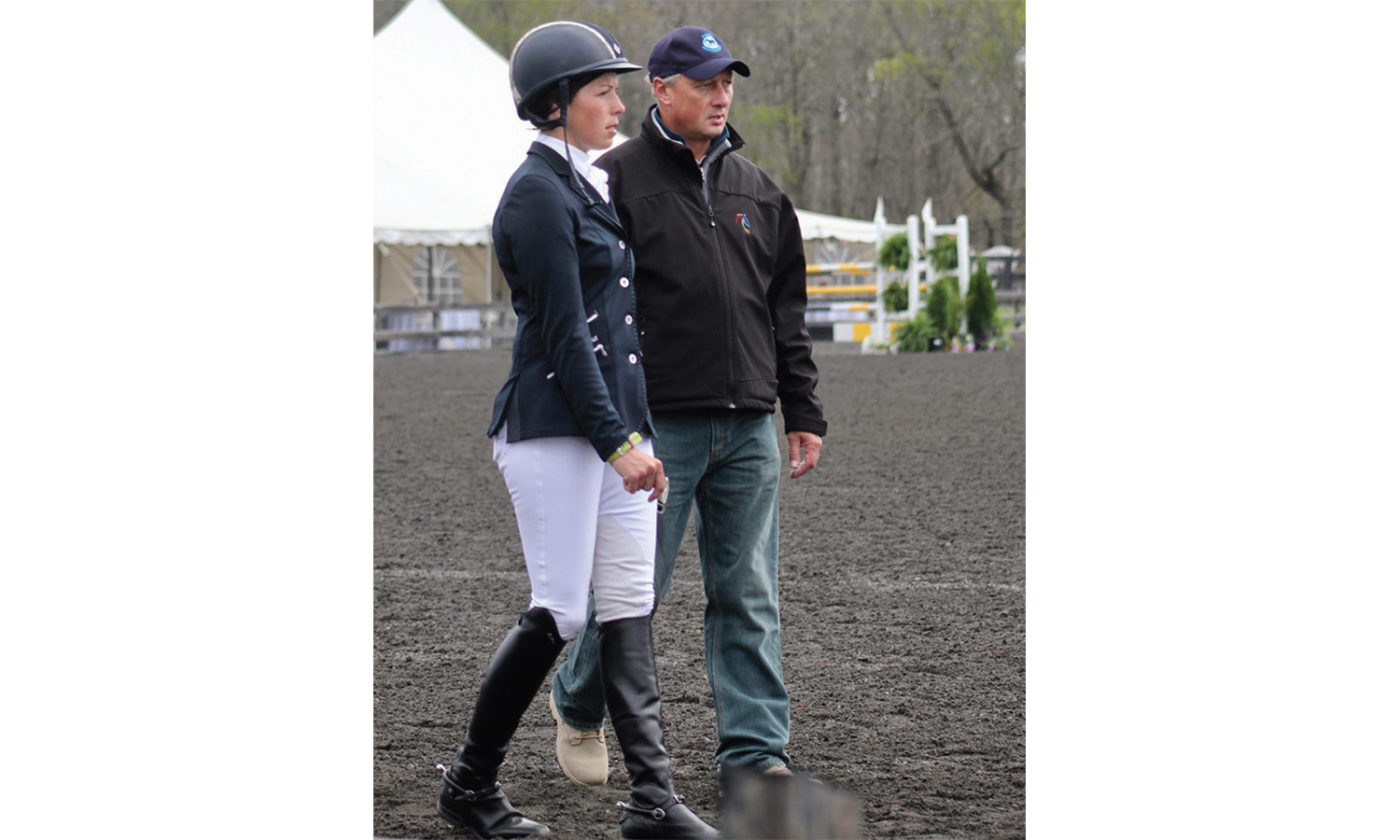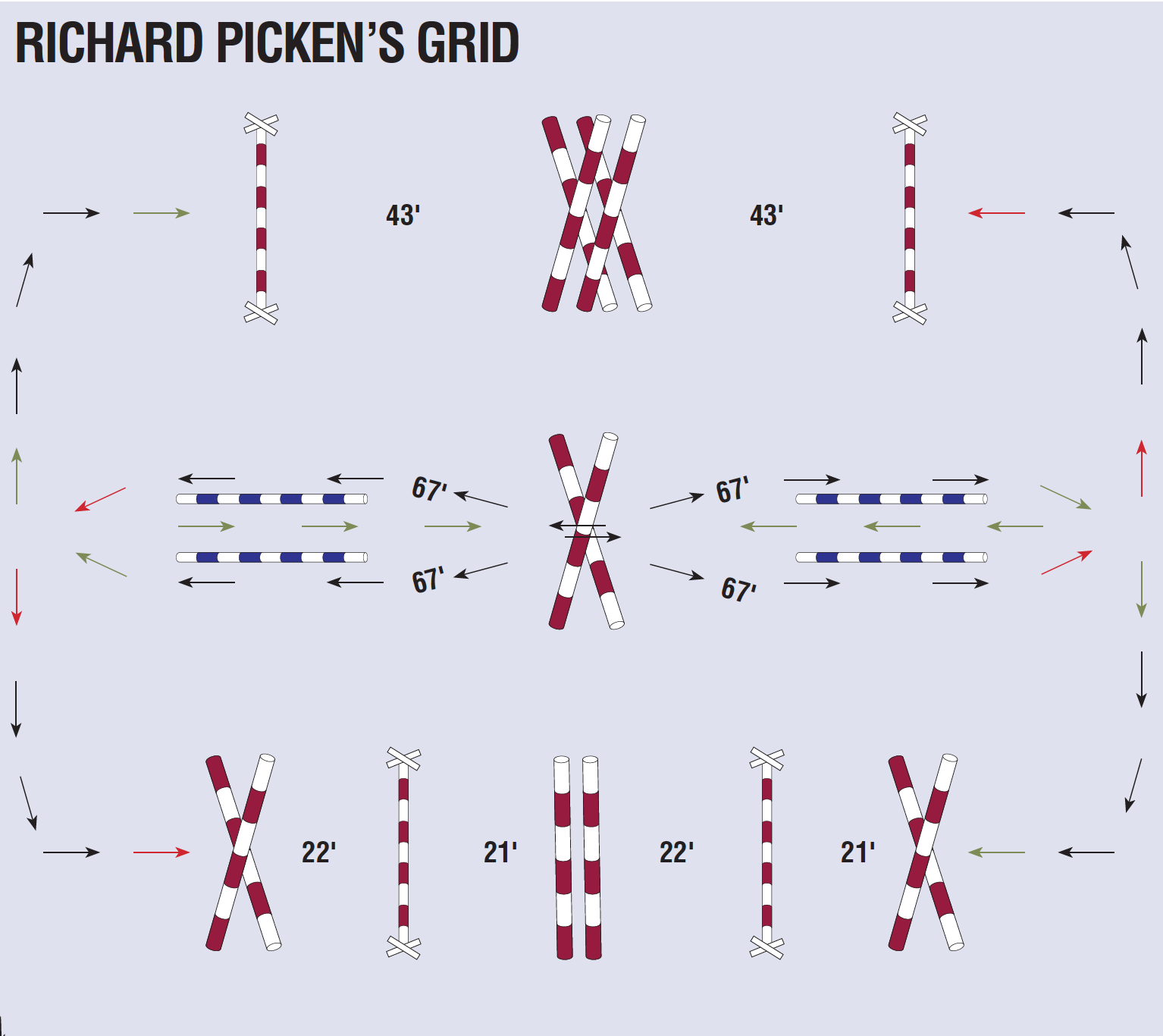

Ready to spice things up this winter training season? Do you want to use being stuck in the arena as an opportunity to fine tune your riding? In this series, we are revisiting some of our favorite Grid Pro Quo articles from Eventing USA to help you use the off-season to your advantage and keep you and your horse in tip-top shape for when it's time to get back out there. Click here to check out other past Grid Pro Quo exercises!\
If you’ve been to any of my recent clinics, you are probably familiar with the centerline exercise featured here. It is a staple to my program for several reasons, the main one being that it is suitable for horses and riders of all levels. While the exercise is fairly basic on paper, it is quite effective in teaching the rider about two important concepts: inside leg to outside rein and using your leg before your hand.
As you land off of the centerline cross-rail and leg yield to either side of the rails on the ground, you will help solidify teaching your horse to move off your leg, specifically your inside leg. The rails on the ground are a great visual for how reactive your horse is, or isn’t, to your leg. Once you are easily able to move your horse off of your inside leg, you can then remember that feeling when you come to a corner so that your horse does not fall in. The same concept applies when you’re riding a bending line of multiple fences.
When teaching, I often see the riders try to use their reins to move their horses to either side of the rails on the ground. It won’t take more than a time or two through the exercise for the riders to realize that they need to put their leg on to initiate their horse moving over. Since the centerline obstacle is simply a cross-rail, you can repeat this exercise over and over until you get it right.
The remaining exercises in the diagram give riders plenty to do to have a complete jump school. You’ll quickly notice that the distances aren’t always perfect, and they are meant to be adjusted by a foot or so here and there. In modern eventing, not all course designers are going to set up the perfect distance every time. So it’s best to practice these slightly odd distances in your everyday life so that you learn to adjust the horse’s stride throughout your courses.
Another reason why I love this set up is that it teaches riders (and horses) that it’s not the actual distance that’s important. It’s how the horse is jumping the jumps. So even if you spent your first day or two with this exercise with all the rails on the ground, you can work with your horse to create an adjustable canter that can jump any jump from any distance.

When teaching clinics, where I may not be familiar with the riders, I like to watch them warm up. Not only does it give me an idea of where the pair are in their training, but it gives me an idea of how they work together as a team. Regardless of their level of training, I like to see that the riders are able to seamlessly move their horses forward and back, and laterally from side to side. By seamlessly, I mean that I want to see the horse is accepting and responsive to the rider’s aides.
Once I feel that the horse and rider are working together as a team, I will have them start with the top line, but will take the oxer out so there are just the two cavaletti on the ends. Then I will ask the riders to tell me how many strides they put in between the two cavaletti. From there we will work on adding and taking out strides between the cavaletti to work on adjustability. Depending on the level, I will expect the riders to be able to add or take out one to four strides.
As soon as the horses are able to seamlessly play with the striding in both directions between the cavaletti, I will add in the oxer and build it up until it’s at an appropriate level for the horse and rider. Keep in mind that this is a cross-rail oxer, which helps the rider visually stay centered, and encourages the horse to be a bit more tidy with their front end.
From here we’ll move to the bottom line, and once again I like to start by having the riders go through it a few times with the jumps taken out before adding in the jumps. I often have people question why the distances are just slightly different for this line, and my reason is quite simply: while it’s only a foot difference, it’s enough to make a difference. Keep in mind that this particular exercise is a little easier when you approach it from the 22' distance, so I do like to start with that approach. As I mentioned earlier, I like to mix things up a bit so that the horse – and rider – gets used to thinking throughout their course. The goal is to be a proactive rider, not just a reactive rider.
Once I feel that the horses and riders are straight and adjustable, in relation to their riding level, I will move on to the middle exercise. Again, I will simplify this exercise to start, and put the center line cross-rail poles down on the ground. The first two exercises focused on longitudinal adjustability, and this exercise focuses on latitudinal adjustability. As discussed earlier, the idea is to leg yield to either side of the poles on the ground. As the jump gets bigger, the rider will need to concentrate on staying tall in the saddle, so that when you land you are ready to start your leg yield.
I find that the biggest problem in course riding is riders cutting their corners. The goal of this entire jump sequence is to help with this common issue. So once riders have mastered each exercise individually, I will put together small courses utilizing different aspects of the exercises set up. Regardless of the size of your jumping arena or your course, riders should always work on staying on the rail between the exercises. If riders are still struggling with their horses falling in on turns, I will instruct the riders to think of taking one more stride before turning to their next jump.
While advanced riders can move through all of these exercises in one jump school, I often recommend riders leaving this exercise set up in their arena for a week or two and gradually work their way through it. If you have a smaller arena, you can put the centerline exercise across the diagonal. And the other distances can be adapted to fit into your space. And keep in mind that different horses need different things, so don’t be afraid to adapt as needed.
Richard Picken grew up in the North of England and being a son of a show jumper began life riding show jumpers in the United Kingdom. When he turned 16, he left home to work in Holland and Canada for nearly three decades where he rode with Graham Fletcher, Stal Hendrix, George Morris, and Ian Millar. Following his time in North America he returned to the U.K. and continued to work in the horse business, training and riding in addition to running a successful road transport company. This evolved into working on several major logistics projects including Olympic, World Equestrian, and Asian Games.
Once Picken married Joanie Morris, he moved to the U.S. and got back to his roots, and his passion – show jumping training. His clientele now is predominantly eventing riders and include some of the world's best. He traveled to Rio in 2016 to help Phillip Dutton and Boyd Martin, the highlight of which was Dutton’s individual bronze medal. He coaches elite athletes and young riders and fills his days traveling for clinics, coaching at home, or warming up eventers at major competitions around the U.S. and overseas.
Great Britain’s Yasmin Ingham and Banzai du Loir found themselves in a familiar position today at the top of the leaderboard after dressage at the Defender Kentucky Three-Day Event, scoring a 26.0. A year ago, Ingham and “Banzai” led the field heading into cross-country after Friday’s dressage, but they drew an earlier start this year, and Ingham’s got a few more challengers to come tomorrow.
In comparison to many of his other upper-level event horses, Commando 3, or “Connor” as he is known in the barn, is still a newer ride for Boyd Martin, but that hasn’t held the pair back.
Are you following along with the action from home this weekend? Or maybe you're competing at an event and need information fast. Either way, we’ve got you covered! Check out the USEA’s Weekend Quick Links for links to information including the prize list, ride times, live scores, and more for all the events running this weekend.
Let the fun and games begin! This morning kicks off the official start of competition at the 2024 Defender Kentucky Three-Day Event (K3DE). The hefty four-star field is the first to set foot in the Rolex Stadium starting at 8:00 a.m. Last year we saw 49 four-star pairs in this division, but this year there are 63 pairs in the field.